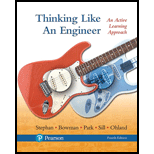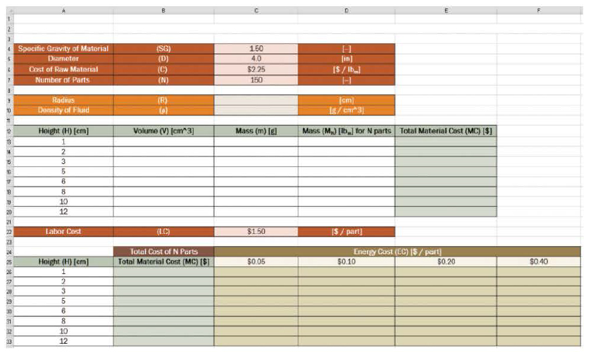
Concept explainers
The worksheet shown was designed to calculate the cost of material that must be purchased to produce a given number of parts. The user will enter the specific gravity of the material, the diameter of the cylindrical part in units of inches, the cost of the raw material in dollars per pound-mass, and the number of parts to be manufactured. All user input is shown in red. The worksheet will calculate the radius of the cylindrical part in units of centimeters and the density of the fluid in grams per cubic centimeter. All conversions are shown in orange.
The worksheet will determine the volume and mass of a single part for a given height. Finally, the worksheet will determine the total mass of material needed to produce the desired number of parts in units of pounds-mass, and the total material cost.
The total material cost appears twice. In cells E13 to E20, a formula is written to determine the cost. In cells B26 to B33, the cells simply reference the corresponding cell in the table above. For example, B26 the formula = E13 appears.
In the bottom table, the total cost for N parts is determined by the formula:
 Total Cost = Total Material Cost + (Energy Cost + Labor Cost) × Number of Parts
Total Cost = Total Material Cost + (Energy Cost + Labor Cost) × Number of Parts
- a. What should be typed into cell C9 to determine the radius in the correct units?
- b. What should be typed into cell B13 that can then be copied down column B to determine the volume of a cylindrical part in units of cubic centimeters?
- c. What should be typed into cell C13 that can then be copied through down column C to calculate the mass of each part in unit of grams?
- d. What should be typed into cell D13 that can then be copied down column D to calculate the total mass needed to produce N parts in units of pounds-mass?
- e. What should be typed into cell E13 that can then be copied down column E to calculate the total material cost?
- f. What should be typed into cell C26 that can then be copied from C26 to F33 given the energy cost in row 25 and labor cost in cell C22 to calculate the total cost of producing N parts?
Want to see the full answer?
Check out a sample textbook solution
Chapter 10 Solutions
Thinking Like an Engineer: An Active Learning Approach (4th Edition)
Additional Engineering Textbook Solutions
Vector Mechanics for Engineers: Statics and Dynamics
Fluid Mechanics Fundamentals And Applications
DeGarmo's Materials and Processes in Manufacturing
Vector Mechanics for Engineers: Dynamics
Heating Ventilating and Air Conditioning: Analysis and Design
Manufacturing Engineering & Technology
- When applying the principles of work and force, work is accomplished when force is applied to an object that does not move in the metric system the measurement for work is cubic centimeters no work is accomplished when an object is stopped by mechanical force if a 50-pound object is moved 10 feet, 500 ft.-lb of work are producedarrow_forwardThe answers for question 1 ie. Volume of each tank is given and attached here. But you need to still show the calculations for itarrow_forwardAnswer in 3 decimal places Two animals were placed on both end of a hydraulic lift system as show below. A mouse with a mass of m=9 g is placed on a smaller piston with a diameter of 10 cm. If an elephant with a mass of 4 000 kg is placed on the larger piston, how wide should the diameter of the larger piston be so that pressures at both ends are equal?arrow_forward
- The small piston of hydraulic jack has a radius of 2 cm. If a force of 50 Lb. is applied to the small piston raises a weight of 2000 Lb., what is the radius of the large pistonarrow_forwardFor the objects shown below sketch the object in the space provided after rotating it about the axis by the indicated amount.arrow_forwardConvert 500 meters squared per second squared to BTU per pound-mass. Answer to the third decimal place.arrow_forward
- A piece of lead with specific gravity of 11.3 is tied to a 130 cubic centimeters of cork whose specific gravity is 0.25. They float just submerged in water. What is the weight of the lead in grams?arrow_forwardHow did you calculated for the area of the sphere used in Q total and as well as Ai and Ao , please show the calculation for are separately. (Only show the computation for areas of the sphere used)arrow_forward3. The specific gravity of a certain alcohol is 0.8. Calculate its specific weight and mass density (in both English and SI units) (3 DECIMAL IN FINAL ANSWER PLS!!)arrow_forward
- If the specific gravity of gold is 19.0, what is the weight of a cubic inch of gold?arrow_forward8. you’ve just won the $12 million cash lottery, and you go topick up the prize. What is the approximate weight of the cash ifyou request payment in quarters and in dollar bills?arrow_forwardUsing only Table A (Conversion of Units), calculate the values asked. All answers must be given with the primary dimensions and units of the SI system. 33 lbm of a substance has a specific volume of 80 dm3/kg , determine the absolute volumearrow_forward
 Automotive Technology: A Systems Approach (MindTa...Mechanical EngineeringISBN:9781133612315Author:Jack Erjavec, Rob ThompsonPublisher:Cengage Learning
Automotive Technology: A Systems Approach (MindTa...Mechanical EngineeringISBN:9781133612315Author:Jack Erjavec, Rob ThompsonPublisher:Cengage Learning
